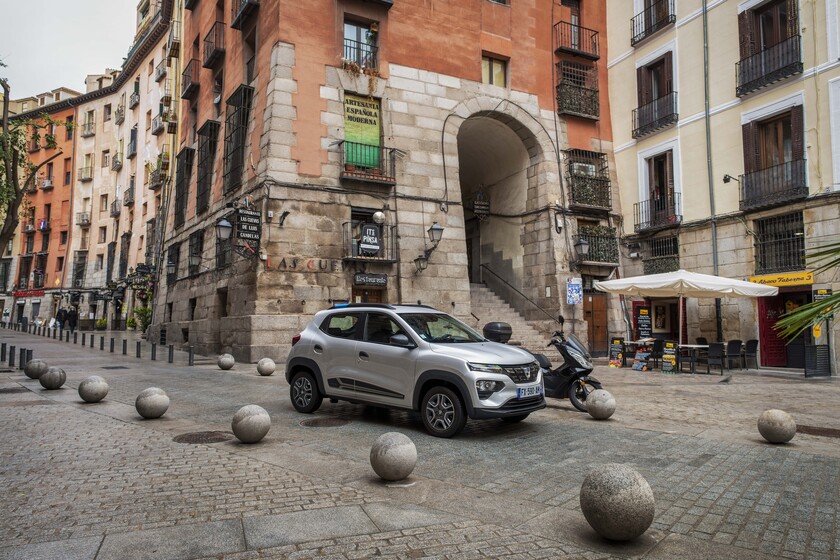Dacia was born 16 years ago as the second brand of the Renault Group with the intention of manufacturing cars with the best price / quality / value ratio on the market. The formula seems to have worked, since to date they have sold more than 7 million units and have managed to place the Dacia Sandero as the best-selling car in its segment to individuals in Spain and Europe. Now Dacia takes a giant step into the future with the launch of its first electric car, the Dacia Spring called to democratize the electric car as it is the cheapest on the market. We have already driven it and we will tell you what we think.
The Dacia Spring is an SUV-looking urban electric car. Measure 3.73 meters long, it has a body of five doors, four seats and it is seen that it is a car with a considerable ground clearance, with 151 millimeters.
At the design level, it follows the philosophy of the Dacia brand. The front has a lot personality thanks to optical groups made up of two blocks, the upper one with the LED daytime running lights and the lower one with the lights that illuminate the road. In the center, we find a black grill decorated with chrome details that hides the battery charging socket inside.

Rims 14 inch with hubcaps that simulate alloy wheels, wheel arches marked by plastic moldings, stickers on the bottom of the doors with the word Electric and some thick plastic bars on the roof are the elements that give shape to this car, which may be more or less like, but there is no doubt that it has a lot of personality.
Four seats and a fairly large trunk
If we go to the interior, we find space for four passengers, where the occupants of the front seats enjoy more space than those of the rear. The trunk is quite large for a car of its size, as it has 290 liters capacity expandable up to 620 liters if you lower the backs of the rear seats.

It is a cabin simple and functional, marked by the use of fairly hard plastic materials. The three-spoke steering wheel has some buttons to activate the speed limiter or to activate the voice control, always linked to the smartphone.
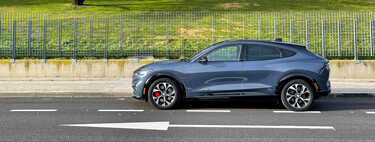
Behind him we find the dashboard, totally electronic in which on the left side we see a color scale that indicates whether we are using or regenerating battery power, while on the right is the indicator of the available charge level.
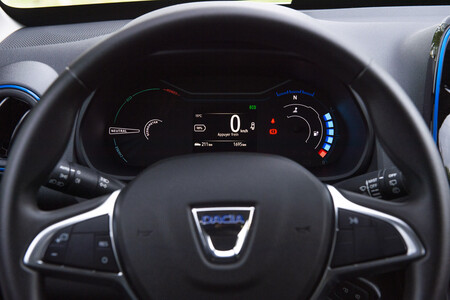
In the center a screen of 3.5 inch allows us to consult the basic information you need while driving.
The Dacia Spring will be on sale with two levels of equipment, Comfort Y Comfort Plus. The second includes a few seats with a rather successful appearance, which are made in a single piece, with the integrated headrest and with details such as the blue stitching standing out in the whole.
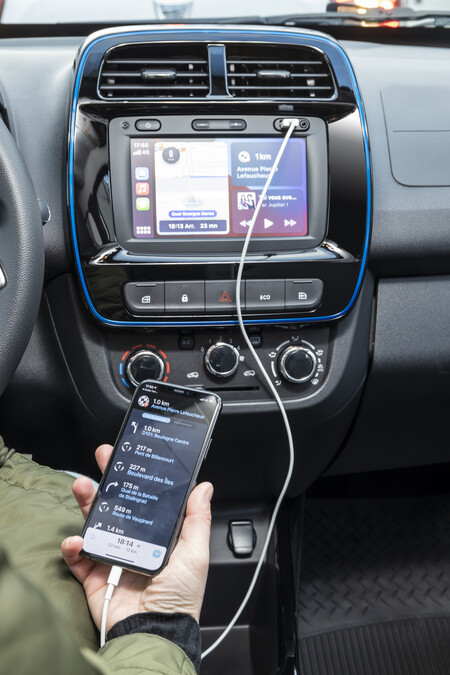
In the center of the dashboard a console framed by glossy black plastic incorporates the dashboard display. 7 inches of the Media NAV multimedia system, with DAB radio, wireless replication of the smartphone compatible with Apple Carplay and Android Auto, Bluetooth, a USB socket and an auxiliary output.
An APP for the mobile phone called MyDacia is also available, from which you can see in real time the battery charge level, the available autonomy and geolocate the vehicle if necessary.
As a technological detail of a higher level, when Spring is connected, the application allows activating the pre-conditioning of the passenger compartment (air conditioning / heating) so that when you get there it is at the right temperature, inform yourself about the progress of the load and put it on pause or resume the latter.
Active and passive safety
In terms of safety, the Dacia Spring cannot be considered a basic car, far from it. As standard it comes with a speed limiter, ABS, ESC, electronic braking distributor, 6 airbags, automatic lighting of the lights and assisted emergency braking.
This last system allows that from 7 km / h of speed, the front radar is activated to measure the distance with respect to the vehicle that precedes us. In the event of detecting a risk of collision, the system warns the driver visually and audibly.

It even automatically applies the brakes if the driver does not brake or does not brake enough, which is an important help.
Mechanical simplicity
The mechanical configuration of the Dacia Spring is the simplest that we can find in an electric car. On the front axle we find a small electric motor of 33 kW, equivalent to 44 horses that is coupled to a battery of 27,4 kWh.

The small size and weight battery is located under the rear seat bench. Thanks to that small battery you can homologate 305 km of autonomy in WLTP urban cycle or 230 km in WLTP mixed cycle.
Also thanks to this mechanical simplicity, the use of a small battery and its size, the car manages to keep the kilos at bay. With 970 kilos weight, we are first and foremost a featherweight among electric cars sold today.

The charging socket is hidden under the front grill and the hatch that gives access to it is operated from the passenger compartment to prevent someone from opening it while the car is parked on the street.
Loading times
The Dacia Spring is clearly a car with an urban vocation. For this reason, it has not been specially designed for fast charging on the road, although it does admit DC charges with a maximum power of 30 kW.
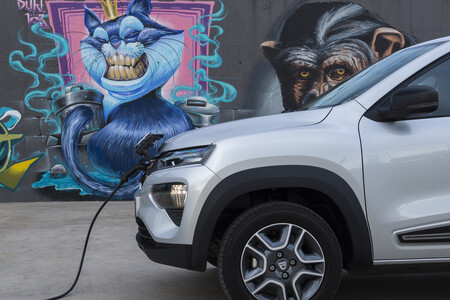
If we prefer to resort to a Wallbox of 7.4 kW to charge it, we will need less than 5 hours to have the battery at 100%. In a home plug conventional, in about 8 hours we will have 80% of the charge, so leaving it at night charging to be able to move the next day without worries is perfectly possible.
According to the data that Dacia showed us, the average journey of a person in Europe is 31 kilometers / day. Thus, with the declared levels of autonomy, the logical thing would be to charge it only once a week.
Driving the Dacia Spring through Madrid
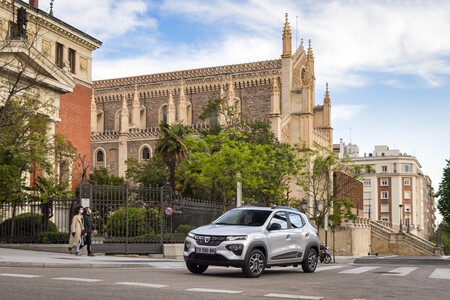
Dacia brought some pre-production units of its new electric car to Madrid so that we could drive it and take the first impressions on how it behaves.
To start you have to to turn a traditional key, no unnecessary starter buttons like modern cars do. Then you have to turn the rotary control located between both seats to select D, N or R. There is no P position to park, just leave it in D or R.

The first kilometers behind the wheel of the Dacia Spring helped me to see how this discreet performance car (0 to 100 km / h in 19.1 seconds), is more agile than I expected and infinitely more agile than the rest of electric cars that I have tried to date.
The address is very coaxing and quite direct, allowing the car to circumscribe itself in the curves quickly. It is noticeable that it weighs very little and that the front wheels have a very pronounced turning radius, which also helps in parking tasks.
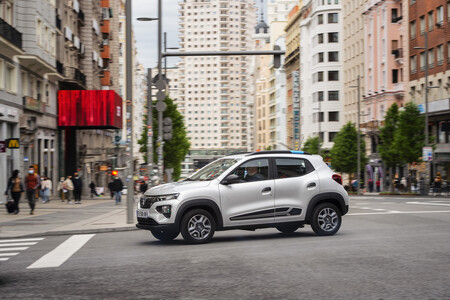
The first few meters of advance are not especially critical because it delivers 125 Nm of torque from the moment you start to accelerate with it. Then you have to keep the foot to the bottom so that the car is reaching cruising speed, and once it has reached it, it is enough to caress the accelerator so that it maintains the rhythms.
On interurban roads, such as the always busy A1 motorway towards Madrid, it is able to maintain speed adequate despite its low power.

When you release the accelerator the car retains and it indicates this to you on the dashboard located behind the steering wheel, where it indicates that it is recharging the battery. Also when you brake it regenerates energy, so much so that by playing with the driving style you will be able to drive very efficiently and get close to the records that it makes of electric autonomy.
It seemed like a car to me very comfortable for its size and price. Its suspension is soft and the absence of noise makes the driving experience more pleasant than the one you can experience behind the wheel of an equivalent combustion car.
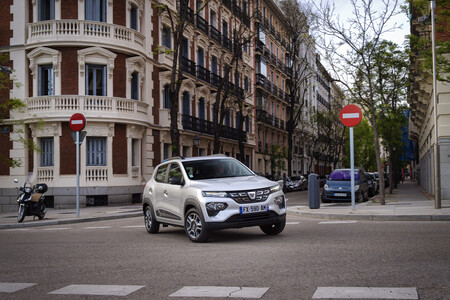
Despite its simple approach, it is a car that perfectly fulfills its mission, an ally for the day to day that does not intend to go further, but to offer those who need an electric car, a cheap and well-resolved one.
To that must be added all the advantage to use an electric car beyond the absence of CO2 emissions, such as parking in a regulated area without having to pay and without time limits, the use of the BUS / HOV lanes with total freedom or the power to circulate without fear of episodes of traffic restrictions due to high pollution.
Cheaper than its combustion equivalents
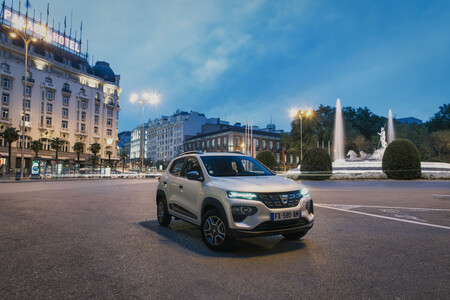
In addition to all this, it happens that the Dacia Spring arrives now that the MOVES III Plan for the purchase of ecological cars has been announced. The rate prices of the Spring, which are 16,550 euros for the Comfort finish and 17,620 euros for the Comfort Plus, remain at 9,550 euros and 10,620 euros with MOVES and scrapping a used vehicle.

We are therefore before him electric car cheapest on the market, a car so cheap that its price is even lower than its equivalents with traditional combustion mechanics. So this is possibly the first car to actually democratically the electric car on our streets.
In Engadget | All electric cars that will go on sale in Spain in 2021 | Porsche Taycan Cross Turismo, this is Porsche’s second electric car with 761 hp and the desire to go out into the field
